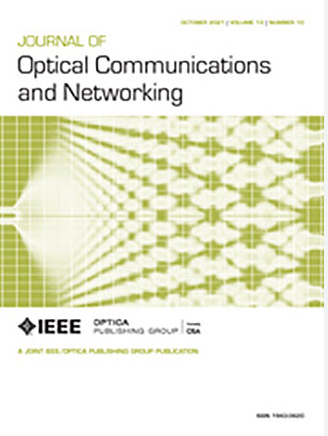Power consumption considerations of coherent transceivers in filterless point-to-multipoint metro-aggregation networks with digital subcarrier multiplexing
IF 4.3
2区 计算机科学
Q1 COMPUTER SCIENCE, HARDWARE & ARCHITECTURE
引用次数: 0
Abstract
With metro-aggregation being a domain between the core and the access network segments, where the main innovation drivers and requirements are high-capacity and low-cost architectures, respectively, it finds itself in a position where it is necessary to address both aspects simultaneously. Coherent digital subcarrier multiplexing (DSCM) in combination with a point-to-multipoint (P2MP) communication scheme offers the possibility to significantly extend the transceiver solutions sustainably. To demonstrate the potential of this approach, we carry out a techno-economic analysis on the basis of realistic, randomly designed, and flexibly configurable filterless metro-aggregation networks under different traffic growth conditions. Our investigation establishes a relation between the design characteristics of a network, its operating conditions, and performance. By evaluating the deployed hardware (i.e., transceivers) in terms of their power consumption, we demonstrate the advantages of optical aggregation and flexible allocation of bandwidth resources compared to full-capacity operation of DSCM-capable modules. Finally, a comparison to the operating conditions of traditional single-carrier coherent pluggables allows us to determine target specifications to manufacture competitive transceivers with DSCM technology.基于数字子载波复用的无滤波器点对多点城域聚合网络中相干收发器的功耗考虑
城域聚合是一个介于核心和接入网段之间的领域,其中主要的创新驱动因素和需求分别是高容量和低成本架构,因此城域聚合发现自己处于一个有必要同时解决这两个方面的位置。相干数字子载波多路复用(DSCM)与点对多点(P2MP)通信方案相结合,提供了显著扩展收发器解决方案的可能性。为了证明这种方法的潜力,我们在不同流量增长条件下的现实、随机设计和灵活配置的无滤波器城域网的基础上进行了技术经济分析。我们的调查建立了网络的设计特征、运行条件和性能之间的关系。通过评估部署的硬件(即收发器)的功耗,我们展示了光聚合和灵活分配带宽资源的优势,与全容量运行的dscm模块相比。最后,与传统单载波相干可插拔器件的工作条件进行比较,使我们能够确定使用DSCM技术制造具有竞争力的收发器的目标规格。
本文章由计算机程序翻译,如有差异,请以英文原文为准。
求助全文
约1分钟内获得全文
求助全文
来源期刊
CiteScore
9.40
自引率
16.00%
发文量
104
审稿时长
4 months
期刊介绍:
The scope of the Journal includes advances in the state-of-the-art of optical networking science, technology, and engineering. Both theoretical contributions (including new techniques, concepts, analyses, and economic studies) and practical contributions (including optical networking experiments, prototypes, and new applications) are encouraged. Subareas of interest include the architecture and design of optical networks, optical network survivability and security, software-defined optical networking, elastic optical networks, data and control plane advances, network management related innovation, and optical access networks. Enabling technologies and their applications are suitable topics only if the results are shown to directly impact optical networking beyond simple point-to-point networks.

 求助内容:
求助内容: 应助结果提醒方式:
应助结果提醒方式:


